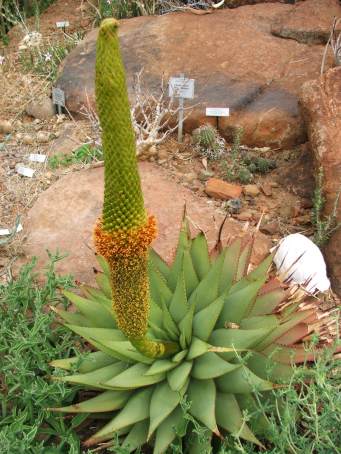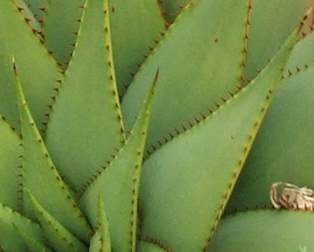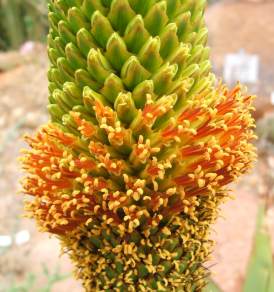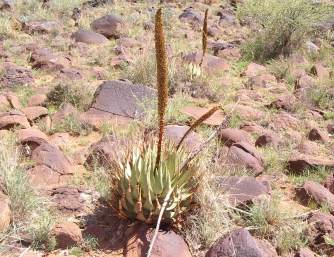Aloe broomii
Aloe broomii Schönland
Family: Asphodelaceae
Common names: mountain aloe, snake aloe (Eng.); bergaalwee, slangaalwyn (Afr.)
Introduction
Aloe broomii has a unique feature that no other aloe has - the flowers and buds cannot be seen when the flower is fully open because they are completely hidden by longer bracts. All that we can see of the flowers are the stamens and stigmas sticking out beyond the bracts.

Description
Description
Aloe broomii is a short-stemmed, robust aloe reaching a height of 1.5 m, including the inflorescence. It is usually solitary, but occasionally the heads divide to form groups of up to 3 rosettes. The leaves are green, with reddish brown teeth along the margins, and are arranged in a dense rosette.

The inflorescence is a densely flowered, un-branched (simple) raceme 1.0 - 1.5 m long. The flowers are pale greenish yellow and 20 - 25 mm long. The buds are completely hidden behind large bracts that are densely arranged like tiles on a roof. The flowers open in an approx. 100 mm wide band from the bottom of the inflorescence upwards, but all that can be seen of them are the stamens and stigmas that stick out beyond the bracts. It flowers during spring, and the seed ripens during summer.

There are two varieties of Aloe broomii: var. broomii and var. tarkaensis. They are distinguished by the size of their floral bracts: var. tarkaensis has shorter bracts so that more of the flowers and buds are exposed; it also has broader leaves, and flowers in late summer.
Conservation Status
Status
Aloe broomii is not a threatened species, it is still common throughout its distribution range. Aloe broomii: var. broomii is Red Listed as Least Concern, and var. tarkaensis is Rare, but is not threatened nor is it declining.
Distribution and habitat
Distribution description
This species has a wide distribution. It is found on rocky slopes in hilly parts of the central interior of southern Africa at altitudes of 1000-2000 m, from the top of the southern escarpment near Beaufort West in the Northern Cape, to near Tarkastad in the Eastern Cape to the Free State in the north, and in Lesotho. Rainfall in this region is mainly during summer, ranging from 300 to 500 mm per annum.

Derivation of name and historical aspects
History
Aloe broomii was collected by Dr R. Broom in 1905 at Pampoenpoort, which is between Carnarvon and Victoria West, so this wonderful species was named after the man who was the first to collect it. It earned the common name snake aloe because of its long, slender, snake-like inflorescence.
Ecology
Ecology
Aloes produce a lot of nectar that attracts bees, sunbirds and ants. Their light, winged seeds are dispersed by the wind. The seeds are often parasitized by very small maize and rice weevils ( Sitophilus spp.) that leave small round holes in the seeds.
Uses
Use
In the Steynburg District farmers use the brownish fluid that comes from the boiled leaves of Aloe broomii to kill ticks, and as a disinfectant, an ear remedy for sheep, and a dip for cattle. A dessertspoonful of juice from the boiled leaves given to a horse makes the blood temporarily so bitter that any ticks on the animal fall off.
Growing Aloe broomii
Grow
Aloe broomii is an ideal water-wise plant, especially in arid and semi-arid regions, and it is frost resistant. It makes an excellent focal point and structural plant in landscaped gardens, and is a good choice for a rock garden.
Grow Aloe broomii in a sunny position in well-drained (sandy), fertile, soil. Add plenty of compost and bone meal to the planting hole and give the newly planted aloe a regular deep watering for the first few weeks - this will encourage strong root growth. As the plant gets established, reduce the amount of water and don't water at all during the rainy season. Established plants can take care of themselves as they store water in their leaves and are well adapted to an arid environment. Add a thick mulch of compost to both feed the plant and keep the roots cool. Mulch will also reduce evaporation and decrease weed growth.
Propagate Aloe broomii from fresh seed treated with the fungicide Apron C (a.i. metalaxyl) and sow in summer. Use a sterile, well-drained, sandy medium and cover lightly with a 2 mm layer of sand. Keep moist and place in a warm, sheltered position that receives good light but no direct sun, and with free movement of air. Germination is usually within 2-3 weeks during the warm summer months. When germinated, harden them off by gradually exposing them to direct sunlight. Prick out when the seedlings are 20-30 mm tall, pot them into a soil mixture consisting of 2 parts sand : 1 part loam : 1 part compost. Take care not to over-water the seedlings, too much water may cause them to rot.
Aloe broomii is susceptible to snout weevil and scale infestation, and to fungal infections. Snout weevils can be combated with Ripcord (a.i. cypermethrin) during late October and November when the eggs are laid. Scale insects can be treated with mineral oils Oleum or Alboleum. But biological control is best: make your garden attractive to wildlife, such as lizards, ladybirds and praying mantids - they prey on many garden pests, and will reduce the chances of pest infestations. A healthy, well-grown plant in the correct position has less chance of developing a fungal infection, but if the plant does get infected, treat it with a fungicide.
References
- Germishuizen, G. & Meyer, N.L. (eds). 2003. Plants of southern Africa : an annotated checklist. Strelitzia 14. National Botanical Institute, Pretoria.
- Jeppe, B. 1969. South African aloes. Parnell, Cape Town.
- Pole Evans, I.B. 1936. Aloe broomii (Liliaceae). The Flowering Plants of South Africa 16: t. 605.
- Reynolds, G.W. 1974. The aloes of South Africa. Balkema, Cape Town, Rotterdam.
- Van Jaarsveld, E.J. 2000. Wonderful water-wise gardening. Tafelberg, Cape Town.
- Van Wyk, B-E. & Smith, G. 1994. Guide to the aloes of South Africa. Briza Publications, Pretoria.
- http://www.lithops.net/aloe_broomii_detail.htm
Credits
Lusindiso Xulubana
Kirstenbosch National Botanical Garden
February 2007
Acknowledgements: Werner Voigt and Ernst van Jaarsveld for helping with information on Aloe broomii in general and on its cultivation and propagation, and for sharing their field observations and experience; Alice Notten for helping with the writing of the article; Philip Nel for sharing his photograph of Aloe broomii in habitat.
Plant Attributes:
Plant Type: Shrub, Succulent
SA Distribution: Eastern Cape, Free State, Northern Cape, Western Cape
Soil type: Sandy, Loam
Flowering season: Spring
PH: Acid, Neutral
Flower colour: Green, Yellow
Aspect: Full Sun
Gardening skill: Average
Special Features:
Horticultural zones






Rate this article
Article well written and informative
Rate this plant
Is this an interesting plant?
Login to add your Comment
Back to topNot registered yet? Click here to register.